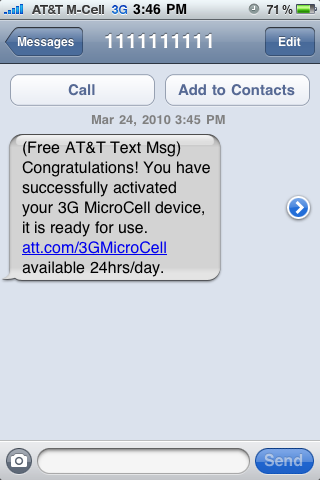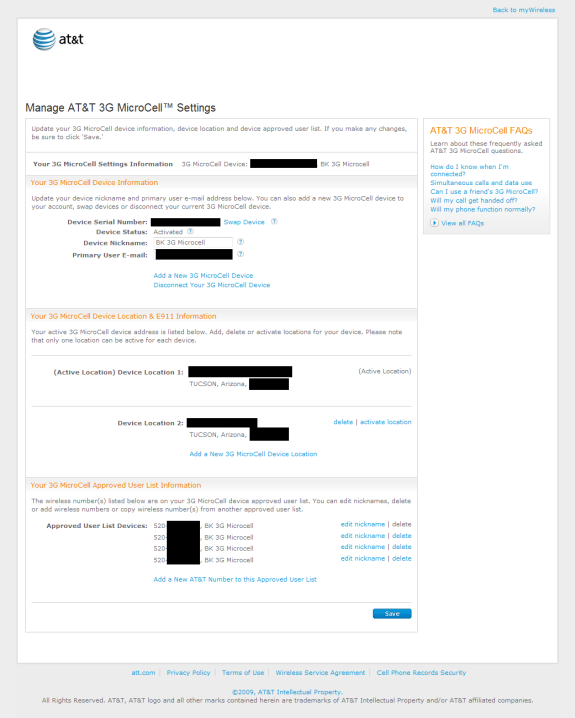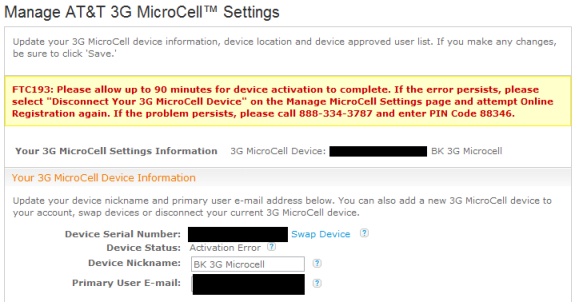AT&T 3G MicroCell: A Comprehensive Exploration
by Brian Klug on April 1, 2010 1:55 AM EST- Posted in
- Smartphones
- AT&T
- Microcell Review
- Mobile
Activating your own personal cell tower
As I mentioned earlier, there's a lot that takes place during device provisioning. Before anything is plugged in, the MicroCell has to be registered online with AT&T for both E911 and spectrum regulatory reasons. As I mentioned earlier, AT&T doesn't want to try and run the femtocell on spectrum they aren't licensed for, and there isn't uniform UMTS 850/1900 MHz licensing across the US. In my market, for example, AT&T is only licensed for the 1900 MHz spectrum.
MicroCell management - Can you micromanage a microcell?
The registration begins by prompting you to enter the device's serial number. Easy enough. Next, it asks for the physical address where the device is going to be used. I was asked for that information while I was at the store, but had to enter it again during registration. This is important because it's used for E911 as well as for verification against the GPS fix the hardware gets. Finally, you enter the approved device phone numbers that will be allowed to use the microcell. At last, you're told it's ok to plug everything in, and it's time to wait - and believe me, wait you will. This is a process that can take up to an hour, though in practice at the two locations I tested, I saw times of between 20 minutes and a 45 minutes.
There's a lot going on behind the scenes during this process, which explains why it can take some time. I noticed on my hardware during the first activation process that the device restarted cold at least once - it's highly likely there's a firmware update with security fixes and updated software that happens. It's also listening for and building a list of macrocells in range for its handoff list, adjusting its own transmission power, and collecting information about what frequencies are active in proximity. All the while trying to get a good GPS fix and provision itself on the network. After the GPS indicator is solid, the 3G indicators will flash either long pulses or very short pulses until the process is complete. Again, there's zero documentation about what long pulses versus short pulses means, but I saw alternating random patterns of both each time. The whole time, aside from the blinkenlights on the hardware, your only status page is the MicroCell management page in the screenshot above. There's very little in the way of communicating what's going on, it'll just let you know that activation is still pending, it's failed, or it's complete.
Oh noes! I didn't take it apart, I swear!
Both times I did this, at the very end of the process the status page briefly communicated that the worst had happened - activation had failed. It's confusing because you'll see the 3G light go solid and your phone join the microcell, but the page will show failed for a minute. Don't panic, look down at your phone. If everything went fine, you should now see "AT&T M-Cell" if you have an iPhone or "AT&T MicroCell" on other hardware as the carrier string:

Yes, they also send you an SMS and email with the news
It took some of my phones just a few seconds to join the microcell and show the carrier string, it took others a minute or two. I found that restarting the hardware unsurprisingly sped the process and assuaged my impatience. Now that it's working, how well does it work?












63 Comments
View All Comments
MyTechLife2 - Tuesday, April 6, 2010 - link
Thanks for the in-depth review! I got my MicroCell yesterday and have been testing it thoroughly. I've also experienced problems on the opposite side of the house from the MicroCell with deteriorating call quality, dropped calls during hand-off and even after hand-off. I call 611 so my test calls are free (I didn't get a MicroCell calling plan). There's an extensive thread on the AT&T forums about dropped calls http://forums.wireless.att.com/t5/AT-T-3G-MicroCel...A few initial observations:
• It runs on 1900Mhz, even though AT&T also has 850Mhz spectrum here. I use the SignalLoc BlackBerry app to check this and other call stats.
• In my 2-story 2100 ft. house, the MIcroCell is located on the northernmost upstairs end of the house. Sometimes on the southernmost downstairs end of the house it will often switch from the MicroCell to the cell network. Locking my phone to 3G only seems to have minimized that.
• I had a situation where I was on the MicroCell, but it was showing "SOS only". Putting the MicroCell in the DMZ on the router and power-cycling the MicroCell seems to have fixed that for now.
• 2 of our 3 phones had to be power-cycled before they would recognize and switch over to using the MicroCell.
• In the far side of my house while while standing still, signal strength will fluctuate from -110 (worst) to -70 (best) on my BlackBerry Bold 9700. About every 1/2 second It fluctuates down about 1 bar until it reaches 1 bar, then right back up to 5 bars. Seems like some power shifting going on.
• The 3G antenna seems to be somewhat directional. I seem to get the best coverage on the far end of the house when the front of the device is pointed in that direction. I tried laying the unit horizontally with the top of it facing the far end of the house and that killed signal strength there. I was hoping to get some down-tilt in the antenna pattern to reach the far end downstairs, but that wasn't the way to do it.
Did you experiment with placement of the device?
mobius147 - Sunday, April 25, 2010 - link
My unit covers one or two rooms at the most. In attempting to purchase additional units in our area ATT will refuse to sell more than one unit per household. Reason given is that the units will nothandoff to one another. Still looking for a way to cover more of the house.
Does anyone have information on the units mentioned in the review that are used in the
Apple stores.
My uplink data rate seems capped at 50 Kb or so and downlink about 1.5 Mb. Adequate for phone
but "light" for data compared to a standard cell site.
Im sure more folks have come up against the limited coverage. Interested to hear possible
remedies.
Raajah - Saturday, December 11, 2010 - link
Wonder if anyone has noted the fact that Microcell looses the wireless connection each time a phone call is received or made from a landline conneted. To be sure, I need to mention that we have dsl from Bellsouth as well as the land line from the same company. There seems to be a conflict that occurs probably because voice calls are carried on the same line connected to dsl service. In this situation it is not worth buying the Microcell.SonarTech - Monday, December 20, 2010 - link
There are actually two tamper traps inside the AT&T Microcell - one on the front of the PCB, and once on the back. The FCC pictures don't show the full tamper mechanism installed on the board, only the empty headers. The top-side tamper trap is located to the upper-right of the Ralink chip, U37, and consists of three jumper headers sitting side-by-side. During assembly, a gray plastic frame sits over this header. After that frame has been installed, three jumpers are installed on top of the frame. One or two of those jumpers aren't actually jumpers, however - they're just chunks of plastic that looks like jumpers. When the case is installed, two long plastic hooks built into the sides of the case "lock" into the sides of that gray plastic frame. Once locked in place, there's no easy way to remove them. If you attempt to open the case, you'll pull either the front-side or back-side tamper jumpers off the headers and you won't know what order to replace them. The odds of you getting them back in the same order they came off is very low. Once the unit is powered up, the jumpers get checked. If the pattern doesn't match what the unit expects, it goes into a tamper lock-down which, as far as I can tell, is a permanent condition requiring factory JTAG to clear.The rear (bottom) tamper header is located about 3 inches away from the top-side tamper header, near the unpopulated pads of D25. Again, it's a set of three 2-pin jumpers sitting side-by-side. It's also the only jumpers on the bottom-side of the board.
Although very tedious, it IS possible to ascertain the correct positioning of the top-side jumpers (and blanks) with the case installed, but you have to know exactly where to look and what to look for.
The bottom-side jumpers, however, are nearly impossible to see through the installed case, and I haven't yet found an easy way to record their values before opening the case.
If you have no intentions of returning the unit for warranty service, the easiest way to get inside this case without bricking the unit would be to cut the case open, taking extra care around the clips that lock into the gray plastic tamper traps.
Besides - you'll do significant (and very obvious) damage to the case just trying to get it open. You'll break at least 4 clips (that are designed to break, by the way) and you'll likely distort the plastic so it won't go together the right way again anyway.
If you need nice hi-res pictures of the board, top and bottom, I have them - with the tamper traps installed.
SonarTech
SonarTech - Monday, December 20, 2010 - link
One last update: The top-side tamper header is screened as J15, and the bottom-side header is J16. Both have traces that feed right into the Ralink RT2150F chip (U37).ivioo - Monday, April 11, 2011 - link
I was wondering if you can show me where the tamper jumpers go. I'm pretty sure I know where 1 jumper goes but I have 2 jumpers left that I don't know where they go and then the 2 dummy onesvsa1977 - Thursday, March 3, 2011 - link
This article seems to be well written based on facts. I however am an end user and have little knowledge on how this stuff works.This article states that "GPS is critical for getting very precise and accurate timing signals for the radio without expensive clock hardware". Would it make any difference in terms of performance if I get an external GPS antenna and connect to this Microcell? I have the microcell placed in a closet since my networking components are deployed there and the GPS at that location is pretty weak.
Calls using the microcell is not often clear and I lose the signal all together maybe once in two weeks. I then have to resync-lock with GPS by taking it closer to the window and then back into the closet again.
Is there any way to increase the range of the microcell by using any kind of external boosters or gain antennas? I do not see any options to connect any external antennas.
I would appreciate if I get an answer on the external GPS antenna's effect on performance.
akaken - Wednesday, July 20, 2011 - link
you dont have to pay that 19.99 charge for unlimited microcell calling but what it does is give you UNLIMITED MINUTES WHILE YOU ARE ON YOUR MICROCELL your plan minutes are not used while on your microcell.MSSS - Monday, September 26, 2011 - link
In an urban area near UC Berkeley (20min from SF) we are in a "dead zone" with irregular tower access.With the Microcell, we get constantly dropped calls and cannot be heard by the person on the other end of the line, often after a minute or two.
Apparently, the microcell keeps handing off the calls to a mystery tower nearby, and cutting off calls.
here’s what ATT says:
In researching your issue we are not finding any network issues and see that the issue is with the micro cell handing off to towers in the area which will often cause the call to disconnect.
They offer NO solution - they will replace the microcell, just in case it's the problem. But we are frustrated.
One forum suggests moving the microcell to a room with bad reception:
http://forums.att.com/t5/3G-MicroCell/add-option-t...
Re: add option to disable handoffs completely to prevent dropped calls
Options
07:42:21 AM - 05-17-2010
I've stumbled upon an option - put the MicroCell in a room with poor signal from the macro network.
Over the past 6 weeks I've tried the MicroCell in 5 different rooms in my home in an attempt to keep it from handing off the the macro network prematurely. Placing it in the room with the worst signal from the macro network has solved the problem.
The only drawback is that now the MicroCell will not in-call handoff to the macro network when leaving my home, moving down the street. The call always drops now. When it was in other rooms in my home it would successfully hand-off to a nearby cell about 1/2 the time. While a drawback, I've rarely found the need to continue a conversation while leaving my home.
PointTechScottsdale - Wednesday, March 7, 2012 - link
Just wanted to post a note to thank you for this great dissection of the microcell. Your work and writings are by far the best that I have been able to find on the web over the last six months.You had just the right amount of detail about just the issue I was looking for. Thanks and keep up the good work!
Elliott
--
Point Technologists
Scottsdale, AZ
(480) 744-6464